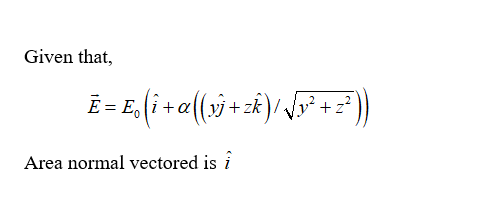Problem 7: A square surface of side length L and parallel to the y-z plane is situated in an electric field given by E(x, y, z) = Eo[i+ a(yj+ zk)/V( +z)]. The square's sides are parallel to the y- and z-axes and it is centered on the x-axis at position Pg. Its normal vector points in the positive x-direction. a is a unitless constant. Refer to the figure. The x-axis points out of the screen.
Problem 7: A square surface of side length L and parallel to the y-z plane is situated in an electric field given by E(x, y, z) = Eo[i+ a(yj+ zk)/V( +z)]. The square's sides are parallel to the y- and z-axes and it is centered on the x-axis at position Pg. Its normal vector points in the positive x-direction. a is a unitless constant. Refer to the figure. The x-axis points out of the screen.
Related questions
Question
P7E5
![Problem 7: A square surface of side length L and parallel to the y-z plane is situated
in an electric field given by E(x, y, z) = E[i+ a(yj + zk)/V(y + z) ]. The square's sides are
parallel to the y- and z-axes and it is centered on the x-axis at position Py. Its normal vector
points in the positive x-direction. a is a unitless constant. Refer to the figure. The x-axis points
out of the screen.
Pr
Part (a) Integrate to find an expression for the total electric flux through the square surface in terms of defined quantities and enter the expression.
Part (b) For L = 8.2 m, E, = 309.9 V/m, and a = 9.9, find the value of the flux, in units of volt•meter.](/v2/_next/image?url=https%3A%2F%2Fcontent.bartleby.com%2Fqna-images%2Fquestion%2F88c43c50-42d9-4dc0-b327-0989874cc0b6%2F4c00b435-3c39-443c-943d-dd1adc84467c%2F1areiyz7_processed.jpeg&w=3840&q=75)
Transcribed Image Text:Problem 7: A square surface of side length L and parallel to the y-z plane is situated
in an electric field given by E(x, y, z) = E[i+ a(yj + zk)/V(y + z) ]. The square's sides are
parallel to the y- and z-axes and it is centered on the x-axis at position Py. Its normal vector
points in the positive x-direction. a is a unitless constant. Refer to the figure. The x-axis points
out of the screen.
Pr
Part (a) Integrate to find an expression for the total electric flux through the square surface in terms of defined quantities and enter the expression.
Part (b) For L = 8.2 m, E, = 309.9 V/m, and a = 9.9, find the value of the flux, in units of volt•meter.
Expert Solution
Step 1

Trending now
This is a popular solution!
Step by step
Solved in 2 steps with 2 images

Expert Answers to Latest Homework Questions
Q: Which item would appear on the statement of retained earnings?A. DividendsB. InventoryC. Prepaid…
Q: What does a classified balance sheet do that an unclassified one does not?A. Uses the cash basis of…
Q: 4. The normal balance of an asset account is:A. CreditB. DebitC. ZeroD. It depends on the assetno ai
Q: THE FIRST PAGE OF THIS QUESTION SECTION BELOW IS THE FIRST IMAGE UPLOADED, WHICH SHOWS A digital…
Q: 4. The normal balance of an asset account is:A. CreditB. DebitC. ZeroD. It depends on the assetneed…
Q: 4. The normal balance of an asset account is:A. CreditB. DebitC. ZeroD. It depends on the asset
Q: A contingent liability should be recorded only when:A. It is possible and the amount is estimableB.…
Q: A contingent liability should be recorded only when:A. It is possible and the amount is estimableB.…
Q: A contingent liability should be recorded only when:A. It is possible and the amount is estimableB.…
Q: No chatgpt
6. Which of the following is not an intangible asset?A. GoodwillB. PatentC. TrademarkD.…
Q: Need help hi
6. Which of the following is not an intangible asset?A. GoodwillB. PatentC. TrademarkD.…
Q: 6. Which of the following is not an intangible asset?A. GoodwillB. PatentC. TrademarkD. Land
i need…
Q: 6. Which of the following is not an intangible asset?A. GoodwillB. PatentC. TrademarkD. Landneed…
Q: 6. Which of the following is not an intangible asset?A. GoodwillB. PatentC. TrademarkD. Land
Q: Which basis of accounting recognizes revenues and expenses when cash is exchanged?A. AccrualB.…
Q: Which basis of accounting recognizes revenues and expenses when cash is exchanged?A. AccrualB.…
Q: Which basis of accounting recognizes revenues and expenses when cash is exchanged?A. AccrualB.…
Q: Answer questions 2
Q: THE FIRST PAGE OF THIS QUESTION SECTION BELOW IS THE FIRST IMAGE UPLOADED, WHICH SHOWS A digital…
Q: Financial Accounting Question Solution with Detailed Explanation and Correct Answer
Q: In the business model, the cost structure is said to be determined to allow for acceptable profits.…